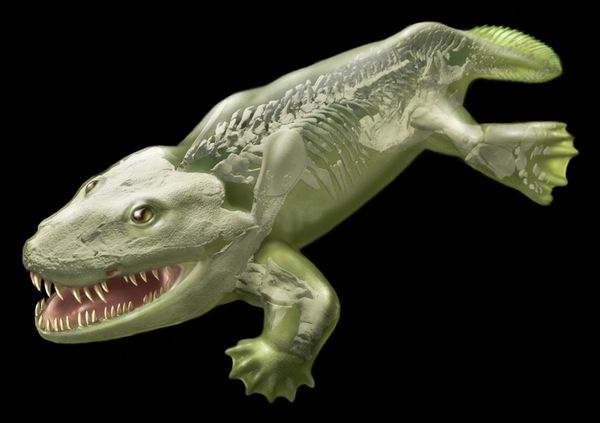Evolutionary Flop: Early 4-Footed Land Animal Was No Walker?
An artist's rendering turns Ichthyostega's skin translucent to show fossils scanned for a new study.
One of Earth's earliest four-footed land animals couldn't walk, a new 3-D model suggests.
Instead, the dog-size Ichthyostega likely flopped on land, using only two of its four stubby legs for locomotion.
One of our most distant ancestors, Ichthyostega is also one of the earliest tetrapods known to have crept onto land.
Until recently, researchers thought the creature squiggled across the mud on all fours like a salamander. But the first 3-D digital reconstructions of Ichthyostega's skeleton suggest its forearms couldn't twist and turn enough to enable a four-legged gait.
The model also suggests that the creature's hind legs barely touched the ground. At best, they may have propped up Ichthyostega's rump as the animal flopped around like a modern-day mudskipper fish.
"When Ichthyostega fossils were first being found in Greenland in the 1920s, the natural assumption was that something with four limbs with digits could walk," said paleontologist Stephanie Pierce, of the Royal Veterinary College in London.
"But now we have more fossil specimens, more species, and more tools," said Pierce, who co-authored the new Ichthyostega study, published May 23 by the journal Nature.
"We definitely know that they were moving more like a mudskipper than [like] modern tetrapods."
"Magic" Fossils
Four-limbed land animals with skeletons first arose in the water, scientists think. Only after millions of years of evolutionary change did they hit the beach during the Devonian period (prehistoric time line).
The earliest signs of their transition from swimming to walking are fossilized tracks that date back about 390 million years—about 30 million years before the first evidence of Ichthyostega was laid down.
To see how Ichthyostega might have made tracks, Pierce and her colleagues built a 3-D computer model by scanning a remarkably complete fossil from Greenland dubbed "Mr. Magic." Missing parts were filled in with scans of fossil bones from 12 other Ichthyostega specimens.
For comparison, the team also scanned and modeled the skeletons of a modern crocodile, otter, seal, platypus, and salamander.
"We moved the animals in a controlled way in the model, and Ichthyostega seemed to be very different from its modern counterparts," Pierce said. "This really highlighted the fact that Ichthyostega must have been doing something different with its legs. The question is, what?"
More Like a Mudskipper
Further analysis hinted that Ichthyostega had very limited forearm motion and a stiff spine. The model also suggested that the hind limbs couldn't contribute to a forward-propelling, four-legged gait.
Instead, Pierce and her colleagues concluded, Ichthyostega likely "rowed" its forelimbs front-to-back, much as a mudskipper moves its stubby front fins to slide around in the muck.
Per Ahlberg, a paleontologist at Uppsala University who calls Ichthyostega "a close friend," said Pierce and her colleagues' work is the first and most thorough of its kind for animals transitioning from water to land.
"This is a really valuable, proper 3-D reconstruction of a Devonian tetrapod and an early land vertebrate," said Ahlberg, who wasn't involved in the study.
One item Ahlberg took issue with in the study, however, is the notion that Ichthyostega didn't do much with its hindquarters.
"There would have been a lot of muscle attachments there, and the pelvis is very large," especially compared with a fish pelvis, he said. That pelvis "had to be doing something significant or it wouldn't be there—the evolutionary cost is too large."
Pierce's team contends, however, that the hind limbs and pelvis were used more in swimming and paddling—Ichthyostega's primary means of motion, the team believes. Uppsala's Ahlberg added, "I bet Ichthyostega's stiff spine made it look bizarre when it was swimming. Sort of like a windup fish toy that you put in a bathtub."
Next, Pierce and her colleagues intend to perform nuanced calculations on the spine and reconstruct a full, lifelike model of movement for the ancient creature.
"The land was an open ecological niche, free to be exploited, and these early tetrapods knew what to do. It was theirs for the taking," Pierce said. "We want to see how they navigated this new environment."
Dave Mosher
for National Geographic News
Published May 23, 2012












